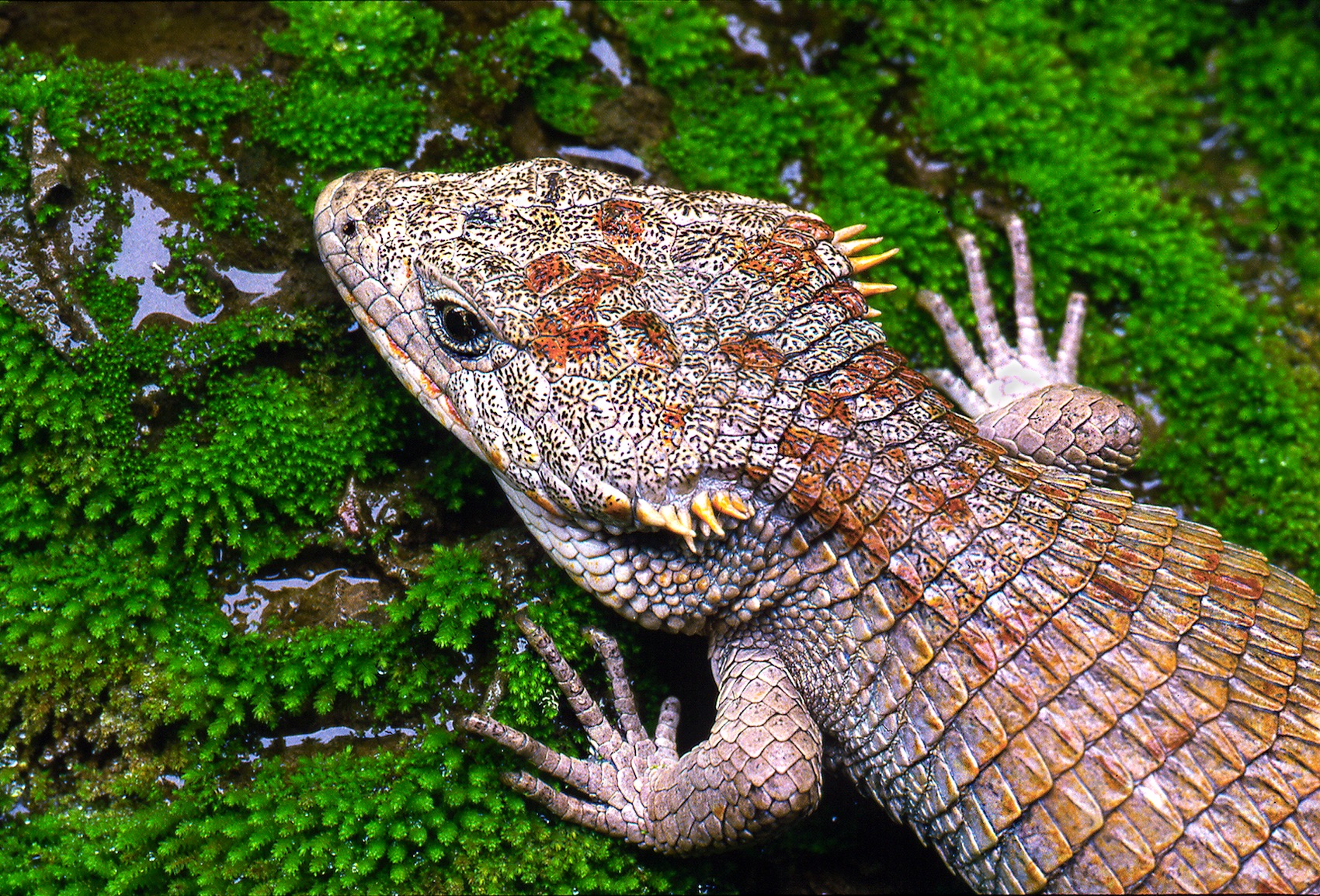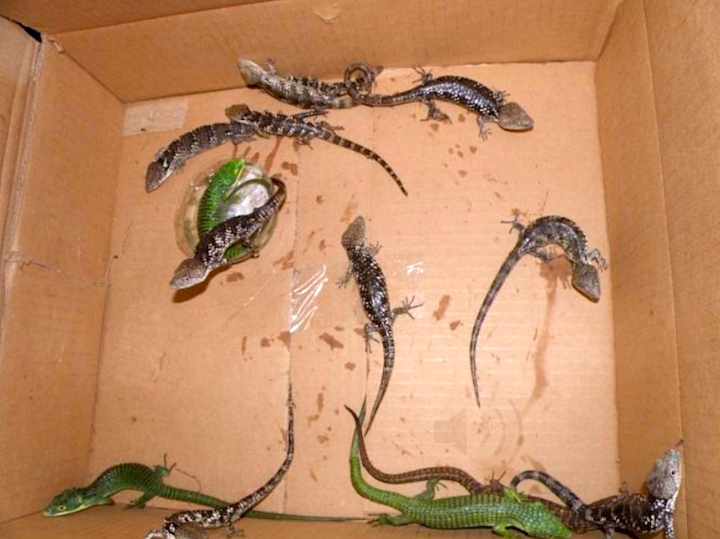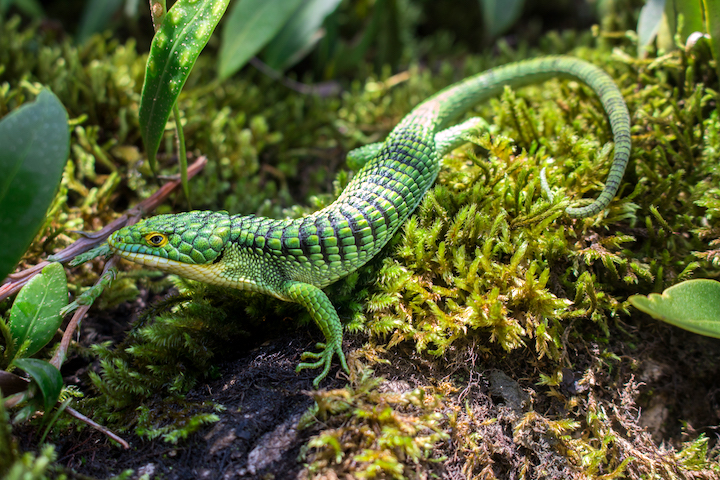- The tree-dwelling lizards of the Abronia genus, native to Mexico and Central America, are traded internationally, often illegally, to supply the exotic pet market.
- Customs officials have found them hidden in socks, concealed in car trunks or squeezed into the double-depth of a portfolio.
- Mexico in 2016 recommended that all 29 Abronia species be listed in the CITES Appendix II, which would impose restrictions on their international trade, but legal traders say this will drive illegal trafficking of the lizards even deeper underground.
They don’t fly, nor do they breathe fire from their mouths, but the “little dragons” of the Abronia genus are the latest craze on the pet reptile market. Far from the image of the huge monsters made popular by TV series such as “Game of Thrones,” these Mexican lizards are completely harmless, although they do have one thing in common: enemies putting them in danger.
In Mexico, they’re known as “scorpions” because they’re thought to be venomous, so “little dragons” is a euphemism meant to improve their reputation so that people don’t indiscriminately kill them.
However, this new name may have catapulted them to unwanted international fame. Hidden in socks inside suitcases, concealed in car trunks or squeezed into portfolios, the little dragons are illegally removed from the country by smugglers who can sell each one for up to $2,000, says Gustavo Jiménez, managing director of Vida Silvestre COATL, a conservation nonprofit that carried out an analysis of the conservation status of the 29 Abronia species in 2015.

In the report on the Abronia genus to be included in Appendix II of the Convention on International Trade in Endangered Species of Wild Fauna and Flora (CITES), there is a confirmed record of Mexican specimens being traded as far as Germany, the Czech Republic, France, Sweden, the United Kingdom, Switzerland, China and the United States.
The main points of sale in Mexico City are the markets of Sonora, Nuevo San Lázaro, Emilio Carranza, and La Viga, with some traders licensed, but many more not, according to Jiménez.
“The largest numbers are taken from places where there are abundant populations close to towns, or at least where there are roads, for example, Chignahuapan [in Puebla state], Puerto del Aire [in Veracruz] and San Cristóbal de las Casas [in Chiapas],” Jiménez tells Mongabay Latam. A. graminea is found in Chignahuapan and Puerto del Aire, A. taeniata in Chignahuapan, and A. lytrochyla in San Cristóbal, Jiménez says. “This is what we understand from what the inhabitants have told us, but we are uncertain of the origin of these animals when the traffickers carry them.”
The lizard trade also involves the use of children, who capture the animals for $1 or $2 each. The smugglers purchase as many as 100 or 200 Abronias at a time from children or people in a position of financial need, and then take them to Mexico City, from where they distribute the lizards to other areas, including across the border to the United States, Jiménez says.

Authorities seized 97 specimens of A. Graminea, A. oaxacae and A. lythrochila between 2005 and 2017, according to data from the Federal Attorney’s Office for Environmental Protection (PROFEPA). But there are no accurate figures for how many of the lizards have been successfully smuggled out of Mexico.
The government permits the legal trade in a handful of Abronia species, says Joaquín Villegas, managing director of Coatlán, a wildlife conservation organization. “The most commercial is Abronia graminea, which is a little green dragon, followed by Abronia taeniata,” he says.
Its fantastical hues may have inspired the colorful alebrije folk art sculptures typically found in the Mexican state of Oaxaca, but A. mixteca’s once abundant presence in the state has declined dramatically due to capture for the pet trade, according to CITES.
Abronias are ideally suited to living in trees. It’s their triangular head, wide, strong jaw, and scale-covered back and tail that give them the indisputable appearance of a cartoon dragon.
Across the Atlantic, the market for these lizards as exotic pets is “practically the whole of Europe,” says Paola Mosig, coordinator of the CITES scientific authority of Mexico’s National Commission for the Knowledge and Use of Biodiversity (CONABIO). “Spanish, German and Dutch authorities have approached Mexico with a list of species that have illegally arrived over the past three years, and the Abronia genus was among them,” she adds.
Dragon fanatics and young people with a hobby of acquiring wild species are among the buyers. “Lately, especially in the United States and Europe, it has become fashionable to have reptilian pets. They don’t need that much care, and now that people are really busy there has been a surge in demand for these reptiles,” Mosig says.
Social networks like Facebook have become the new forum for the illegal trade in many species. “We find adverts for Abronias in many groups,” Villegas says. “We are able to track some of them when they are offered on the online market. Looking at the animals seen in the photographs, [they] have wounded tails or parasites like mites living freely on them.”

The young hobbyist collectors of little dragons are the kind who have “reached a point in their collection where they can no longer legally obtain the species they are looking for,” says Villegas, whose own organization is registered with the government to sell exotic wildlife.
“The trafficking of these species is unprecedented,” says Omar Escobedo, director of another registered wildlife retailer, Moloch Reptiles, and technical coordinator at the Michin Aquarium in the city of Guadalajara. Legal traders need the proper paperwork for each lizard they sell, but there’s nothing stopping illicit traders from reusing older permits. “I have detected at least 200 instances where their permits had been copied using our format and our usage number,” Escobedo tells Mongabay Latam. “It’s outrageous, but it’s very common in the wildlife trade.”

International trade restrictions
At the 2016 CITES conference, Mexico and the European Union requested that the entire Abronia genus, 29 species in total, be listed in the convention’s Appendix II, which would subject the trade in the species to strict regulations. This call for greater protection of these species was justified on the basis of low reproductive potential and the conservation status of their wild populations.
“Prior to their incorporation into the CITES [Appendix II], sales of Abronia in Europe were carried out using specially made false permits to mislead the public,” says Inés Arroyo, a specialist in environmental crimes at the National Autonomous University of Mexico’s (UNAM) Regional Center of Multidisciplinary Investigations.
Her own investigations indicate that the entire trade in Abronia species between Mexico and the EU is illegal, since there’s no data on any single instance of a legal sale of a specimen. “They are endangered species, they are moving through illegal routes, and the quantities, volumes, how many are leaving, and by what mechanisms, is unclear,” Arroyo says. She warns that this problem needs to be tackled using a multidisciplinary approach involving academic institutions, governments, intelligence agencies and international law enforcement.
Arroyo says some of those involved in the lizard trade “don’t care about conservation, they only care about money. They aren’t bothered if Abronias die out. This is what’s called market substitution: If one type of animal is no longer available, they find another. These people have a criminal profile for which CITES is a hindrance, and they are going to find ways to turn the system upside down in order to smuggle the animals.”

Tanya Wyatt, co-author with Arroyo of a report on the illegal trade in wildlife between Mexico and the European Union, says the majority of Abronia seizures occur at Mexico City’s international airport. She says there need to be new international regulations to tackle the illegal trade, as well as better training for customs officials to be able to identify species and distinguish if they are Abronias or other protected wildlife.
CONABIO’s findings, presented to CITES and based on international trade data compiled through official enquiries and internet searches, shows an international market for at least five species native to Mexico that don’t have legal export authorization: A. martindelcampoi, A. smithi, A. deppii, A. lythrochila and A. mixteca.
CONABIO says “the primary destination of these specimens is the Terraristika Hamm trade fair” in Germany, billed as Europe’s largest reptile fair. The specimens are transported within travelers’ luggage, or shipped by courier, first to Spain and France, where they’re kept prior to the fair. Another destination is the United States, where specimens are brought in through border points such as Tijuana, and subsequently distributed from Texas and California. Within Mexico itself, the Abronia trade relies on public buses and private cars to transport specimens from the areas where they’re captured to urban centers like Mexico City, Puebla and Tuxtla Gutiérrez, CONABIO says.
“I think CITES [protection] is a good idea,” Jiménez says. “A step has been taken toward conserving the Abronias, because even though it’s said that CITES isn’t going to solve the problem, it is, in itself, progress. Overseas consumers are now going to seek Abronias that have documentation. This means they are going to expect the Mexicans to sell them with papers, and this may produce sustainable development alternatives within communities instead of fostering trafficking.”

Legal Trade
But for Escobedo, the legal seller, this newly imposed restriction on the trade will hurt the livelihood those who do it within the law, and will only drive the illegal practice deeper underground. “At any time, a point might be reached where the danger of extinction is going to present itself,” he says. “Species that were once common are going to go into special protection and thus we are successively going to nudge all species higher up the risk category.”

Villegas, the other legal trader, says those like him don’t have the capacity to compete with the illegal traders. “Those of us who do this legally invest in facilities for the reproduction and maintenance of the specimens, whereas the others spend very little on removing wildlife from the freedom of its natural habitat and they sell it at a similar or slightly lower price than that of a legal specimen,” he says. “This makes the illegal trade strong, plus there is high demand.” Villegas says wanting one of these animals for a pet isn’t a bad thing, but it’s highly important that buyers educate themselves about the species they’re acquiring, not just to ensure they purchase them through legal channels, but also to support the conservation of the species.
Buyers must demand that sellers provide the documentation to prove the legal origin of the species and endeavor to treat the specimens they acquire both humanely and appropriately.
While films and books continue to popularize fantastical stories of great dragons, these real-life little Mexican lizards may one day fade from the forests that they inhabit in Mexico and Central America and into the realm of legend unless there’s greater awareness about the need to protect and conserve them.
Cover Photo: Peter Heimes.
